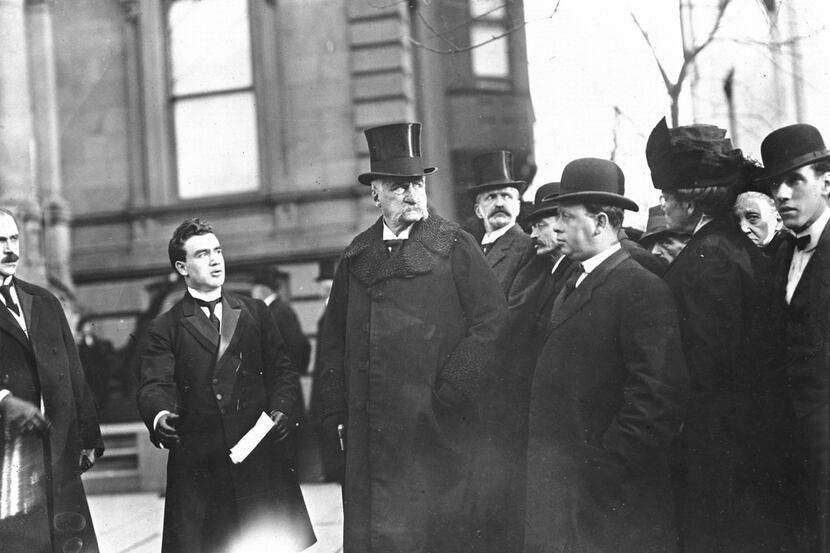The period between the end of the Civil War and the turn of the century brought an abundance of prosperity ... for a select few. Titans with names now synonymous with capitalism — Carnegie, Morgan, Vanderbilt — built vast empires and conspicuously consumed. Meanwhile, factory workers toiled through 72-hour weeks in conditions guaranteed to shorten one's lifespan.
It was the best of times, it was the worst of times, and it all comes rushing back in The Gilded Age, a riveting new documentary from the PBS series The American Experience airing Feb. 6 on KERA-TV. Not that massive economic inequality ever really went out of American style.
As University of Texas history professor H.W. Brands says in the film, "The essence of democracy is equality. Everybody gets one vote. The essence of capitalism is inequality. Rich people are more powerful than poor people." In other words, the 1 percent was cleaning up long before Bernie Sanders was born.
They stride onto the screen one by one in The Gilded Age, ready to conquer the world. There's Andrew Carnegie, the Scottish immigrant turned telegraph operator turned steel lord and "fulltime, independent capitalist." There's Alva Vanderbilt, wife to William, hell-bent on making the nouveau riche acceptable to the stodgy, old-money New York elite. Most formidable was J.P. Morgan, the cutthroat financier who used his iron will and fearsome looks — death-glare eyes, bulbous nose — to put the fear of life into anyone who stood in his way.
These newly minted tycoons preached the connection between extreme wealth and moral virtue. Carnegie was a disciple of Herbert Spencer, the philosopher who coined the phrase "survival of the fittest" as the key tenet of Social Darwinism. Down on your luck? Crushed by the economy (as so many Americans were after the panic of 1893)? Too bad. Must be your fault. Could you pass the caviar, dear?

Of course there was pushback, from a colorful assortment of Americans who saw the emerging status quo as a threat. Mary Elizabeth Lease was a temperance-preaching Kansan who raised hell on behalf of the Populist party. There was Coxey's Army, a protest march of unemployed workers led by Ohio businessman Jacob Coxey. They marched from Ohio to Washington, where Coxey was promptly beaten by police and tossed in jail. And there was William Jennings Bryan, the populist firebrand who railed against big money and lost the 1896 presidential election to the establishment candidate, William McKinley. A remarkable 80 percent of eligible voters turned out at the polls.
The Gilded Age is a prime example of how The American Experience brings a human touch to big topics. Historical research abounds here, along with insight from top-flight historians including Brands, Nell Irvin Painter and Jackson Lears. But it's the outsize characters, more than oil, coal, steel and railroads, that move the story and reinforce the central themes.
Take Alva Vanderbilt. She wanted nothing more in life than to belong with the Astors and their carefully selected paragons of New York high society. She had an ornate mansion built on Fifth Avenue and 52nd Street, and she threw a gala ball in 1883 for her own coming out party. She was welcomed to the club. But then she got divorced, which correct high-society women just didn't do. She was outcast — until she married off her daughter to the Duke of Marlborough. A real-life aristocrat! Alva was grudgingly welcomed back into the swell set. Mary Elizabeth Lease was outraged: "We are now selling our children to titled debauchees."

The Gilded Age might have benefited from a bit of literary flair, maybe a dab of Edith Wharton and her quintessential gilded age novel, The Age of Innocence, or William Dean Howells' The Rise of Silas Lapham. After all it was a novel, Mark Twain and Charles Dudley's The Gilded Age, that popularized the very phrase. But this is still a lively overview of a pivotal moment in U.S. history, a moment that clearly resonates in the present day. As Nell Irvin Painter asks near the end of the film, "Do our governments represent wealth, or do they represent people? That is a fundamental issue which is with us today."
The Gilded Age airs 8 p.m. Feb. 6 on KERA-TV. It will be available on DVD the same day.

